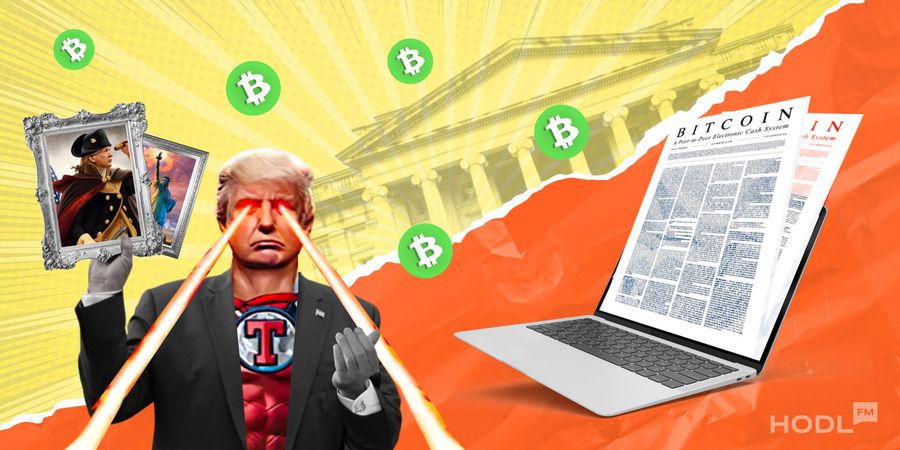Greetings fellow HODLers, and welcome to a new episode of the crypto coinundrums weekly digest, where we talk about the hottest and silliest happenings within the never boring crypto space of the past week.
Today we will talk about:
- Trump NFT’s
- Bitcoin whitepaper in Apple computers
- Decentralized exchanges threatening the US treasury
Let’s dive in!
Trump NFTs: From Courtroom to Crypto Craze
In an unexpected twist of fate, the charge of former President Trump in New York City has had a surprising side effect on the crypto world. Who would have thought that legal drama would spark a frenzy in the NFT market? Well, that’s precisely what happened with Trump’s Digital Trading Card collection.
As the 45th U.S. president faced the courtroom, NFT enthusiasts scrambled to OpenSea, eager to grab a piece of this peculiar moment in history. Trump’s digital collectibles saw an increase in amount of NFT’s sold and the trading volume shot up from 12 ETH to 34 ETH within the hour following his appearance. In a matter of days, the trading volume hit new lows again.
Sure, this sudden spike might seem like small potatoes compared to the booming Nakamigos collection, which boasted 1,286 sales in the same time frame. But considering the Trump Digital Trading Card collection had long been in a state of NFT holder hibernation, this sudden resurgence briefly put the NFT collection on the map again.

Back in December, Trump’s digital collectibles were initially released at $99 a piece, offering buyers the chance to snag an NFT featuring his likeness and enter a sweepstakes for exclusive experiences with the former commander-in-chief. Unsurprisingly, the collection sold out faster than you can say “Make NFT’s Great Again.” Since then, the floor price has held steady at around 0.4 ether (ETH), or approximately $740 at an ETH price of $1850.
Read also: Donald Trump NFT Trading Card Volume Pumps on the Back of Criminal Indictment
Whether you’re a fan of the man or simply looking for a conversation starter at your next crypto cocktail party, one thing’s for sure: the recent Trump NFT sales spike has added a satirical spin to the already bizarre world of non-fungible tokens. So, buckle up, folks! In the realm of crypto, it seems that anything is possible – even when it comes to courtrooms and ex-presidents.
Ironically, someone named “Ponzi trader” sold (or wash traded) this NFT back in Februari for 24 ETH, making it technically “the most expensive” NFT of the entire collection.
Apple’s Crypto Easter Egg: The Hidden Bitcoin White Paper
You wouldn’t expect to find the original Bitcoin white paper on your Mac, would you? But guess what? It’s been hiding in plain sight on Apple computers for years. The crypto community was recently rocked when blogger Andy Baio revealed that the sacred text, penned by the enigmatic Satoshi Nakamoto in 2008, has been secretly nestled within Apple’s MacOS.
Baio wrote, “While trying to fix my printer today, I discovered that a PDF copy of Satoshi Nakamoto’s Bitcoin white paper apparently shipped with every copy of macOS since Mojave in 2018.” Talk about an unexpected treasure! Though Baio’s discovery on Nakamoto’s supposed 48th birthday stirred up the crypto world, Joshua Dickens, a former Apple product designer, had already stumbled upon this peculiar find back in 2020. Unfortunately for Dickens, his tweet about it barely got any attention.
So, how can you fully embrace the Easter spirit and uncover this hidden egg on your Mac? Simple. Just enter the following command into Terminal for macOS Mojave or later:
open /System/Library/Image\ Capture/Devices/VirtualScanner.app/Contents/Resources/simpledoc.pdf
Alternatively, you can navigate to the file using Finder. The white paper seems to be a sample document for Apple’s image capture device, Virtual Scanner II. But the question remains: why did Apple include the Bitcoin white paper in its software?
Well, Apple is notorious for planting easter eggs in its products. From hidden, playable games to “Star Wars” and “Lord of the Rings” references, the tech giant has always enjoyed teasing its users with secret surprises. So, it’s not entirely shocking that Apple would sneak in the first-ever crypto-related easter egg.
Baio mused that the white paper’s inclusion might have been an in-joke by a “secret Bitcoin maxi” working at Apple, or perhaps it was simply a “convenient, lightweight multipage PDF for testing purposes, never meant to be seen by end users.” But given Apple’s historically skeptical stance on crypto – with its former App Store director claiming that the company considered cryptocurrency to be “a Ponzi scheme” – this hidden treasure becomes even more intriguing.
While Apple CEO Tim Cook admitted to owning some crypto in a 2021 interview, he clarified that the company had no plans to invest in it as an asset class. But who knows? Maybe there’s a closeted crypto enthusiast lurking within Apple’s ranks, subtly sowing the seeds of a decentralized future.
For now, we can only speculate on the mystery behind the hidden Bitcoin white paper. But one thing’s for sure: Apple has given us a whole new reason to love our Macs, and the crypto community can’t help but chuckle at this unexpected twist.
DeFi’s dirty laundry: treasury’s 2023 illicit finance risk assessment takes aim
The U.S. Department of the Treasury has taken on the task of taming the Wild West of DeFi in its recently published 2023 DeFi Illicit Finance Risk Assessment. As the first-ever risk assessment of decentralized finance (DeFi) worldwide, this document sets its sights on tackling the murky waters of automated peer-to-peer transactions facilitated by smart contracts and blockchain technology.
In their attempt to decipher the enigmatic DeFi landscape, the Treasury has finally decided to tackle the chaotic whirlwind of automated peer-to-peer transactions, smart contracts, and blockchain technology. After all, it’s high time someone got a handle on this “decentralized” circus, right?
Well, it appears the Treasury is concerned about some shady characters supposedly using DeFi to launder their dirty money. Enter the motley crew of the Democratic People’s Republic of Korea (DPRK), cybercriminals, ransomware attackers, and your run-of-the-mill scammers, who’ve found a playground in the unregulated world of DeFi.
Under Secretary of the Treasury Brian E. Nelson has sounded the alarm, stating that “illicit actors, including criminals, scammers, and North Korean cyber actors, are using DeFi services in the process of laundering illicit funds.” He urges the private sector to put their thinking caps on, use these findings to beef up their risk mitigation strategies, and make sure they’re playing by the AML/CFT rules.
The Treasury points out that the Achilles’ heel of DeFi lies in non-compliance with AML/CFT and sanctions obligations. Fear not, though, for they’ve got a plan! Their recommendations for Uncle Sam include strengthening U.S. AML/CFT regulatory supervision, offering more guidance on DeFi services’ AML/CFT obligations, and closing any regulatory gaps related to DeFi services.
It’s clear that the Treasury is rolling up its sleeves, ready to tackle the underbelly of DeFi’s illicit activities. As they build on their risk assessments and follow the path set out in Executive Order 14067, they’re also extending a hand to the private sector for some collaborative input – because two heads are better than one, right?
So while the Treasury suggests “strengthening U.S. AML/CFT regulatory supervision,” “considering additional guidance for the private sector on DeFi services’ AML/CFT obligations,” and “assessing enhancement to address any AML/CFT regulatory gaps related to DeFi services,” we should ask ourselves: is this really the best approach?
Instead of attempting to force DeFi into a rigid regulatory framework, we should work together – regulators, the private sector, and the DeFi community – to find a balanced solution that preserves the essence of decentralization while mitigating risks.
After all, the world of DeFi is built on innovation and a desire to break free from the confines of traditional finance. Let’s not stifle its potential by drowning it in regulations. We must recognize that DeFi is a powerful force for change and work together to ensure its responsible growth, rather than trying to force it into the mold of conventional finance.
Bitcoin fear and greed index update
The Bitcoin Fear and Greed Index is compiled using data from multiple sources. 25% is derived from volatility, comparing the current volatility and max drawdowns of Bitcoin to the average values over the past 30 and 90 days. Another 25% comes from market momentum/volume, comparing current volume and market momentum to the same timeframes. Social media accounts for 15%, analyzing interactions on crypto-related Twitter hashtags. Surveys, currently paused, should contribute 15% through weekly strawpolls about market sentiment. Dominance, making up 10%, examines the market cap share of Bitcoin and altcoins, with a rising Bitcoin dominance indicating fear in the market as altcoins get sold off. Lastly, trends (10%) factor in Google Trends data for various Bitcoin-related search queries, focusing on changes in search volumes and popular searches, which can indicate fear or greed in the market.
At a fear and greed index score of 68 we are entering a high greed environment. The bitcoin price appears to just have broken out upwards, reaching a price that we only last saw in June 2022.
Historically speaking, the best buy opportunities were during stages of high fear, and sell opportunities during stages of high greed. So make sure you position yourself carefully, nobody ever lost money taking profits.

Bitcoin fear and greed index over the past 6 months. Source: https://freerunnl.nl/btc-index/#/




